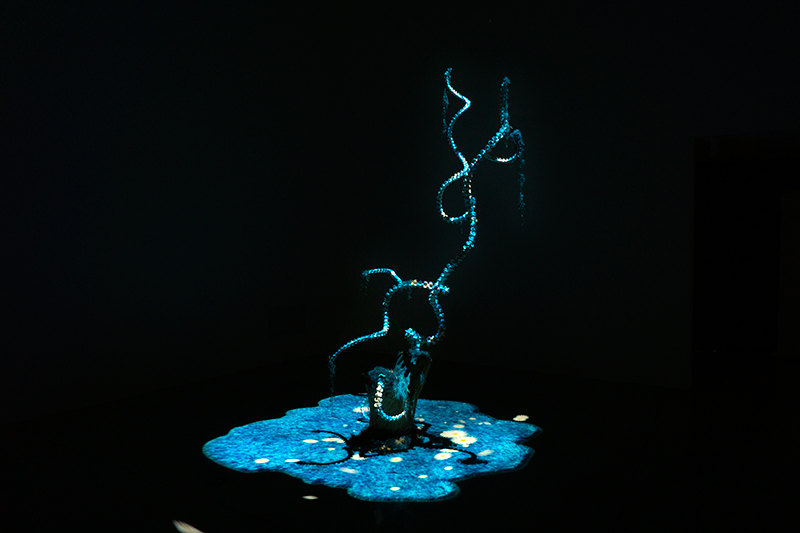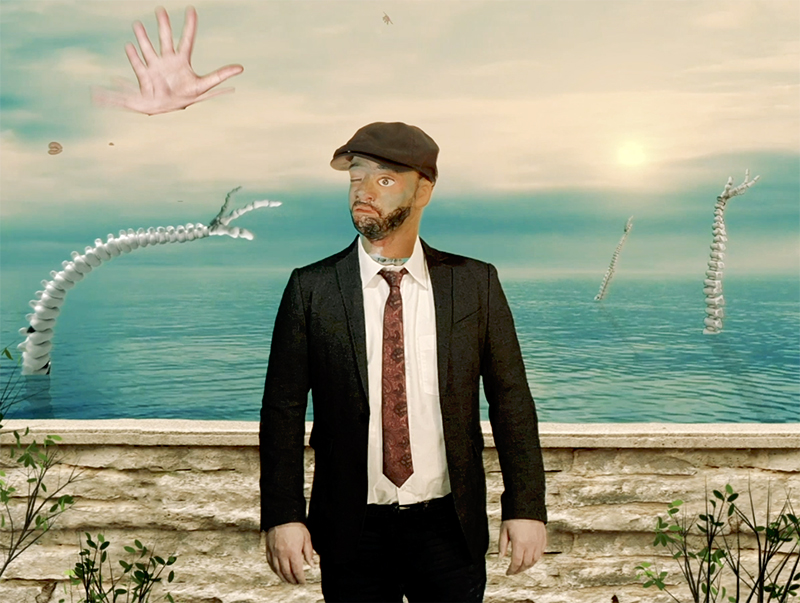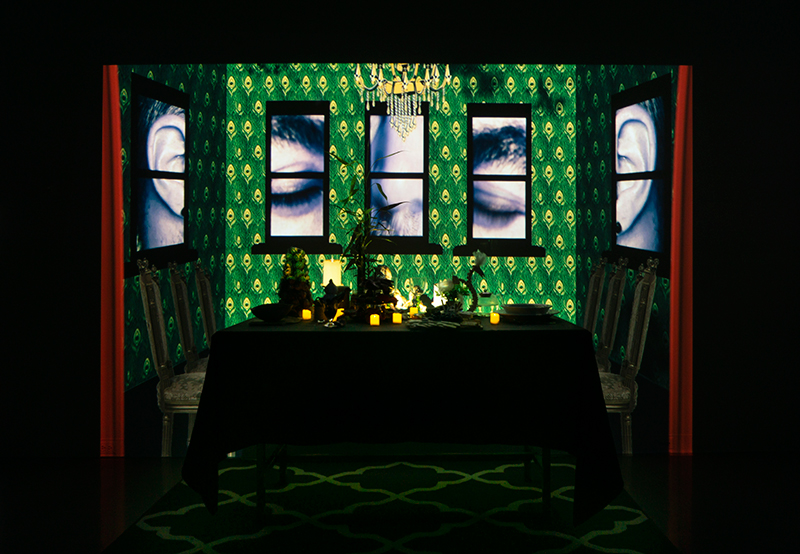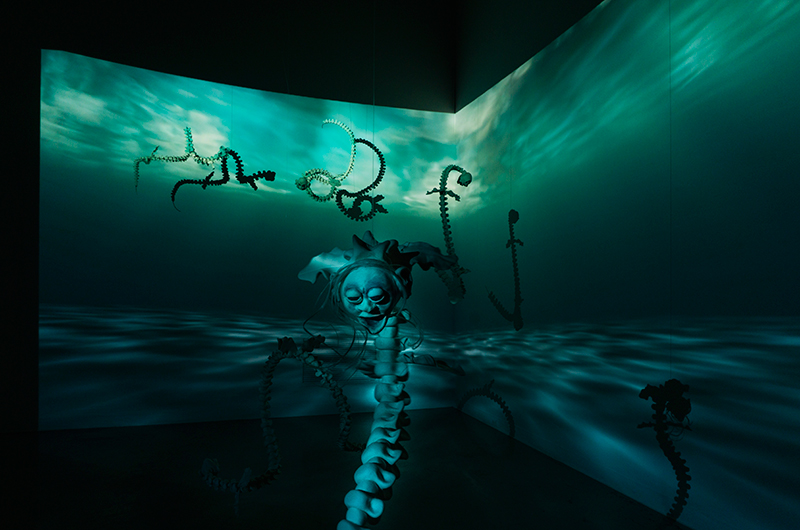Artlab Gallery
Questions?
Program AssistantLinda Meloche
519-661-3440
visarts@uwo.ca
Undergraduate Chair
Tricia Johnson
VAC 200A
519-661-3440
vaugc@uwo.ca
Faculty of Arts & Humanities Academic Counseling
University College 2230
arts@uwo.ca
Sentient Surrealism
Examining the Postmodern Art of Tommy Bourque
Ana Moyer
Published August 31, 2021

The Garden, 2021, digital sculpture installation and floor projection.
The Artlab’s recent exhibition, Marvelous Monsters by artist Tommy Bourque, was a wondrous journey: carefully crafted artworks utilizing sculpture, found materials, digital projections and audio created a fully encompassing experience. Bourque recently completed his MFA at Western University with a focus in experimental digital and installation art. His artworks draw from a deliriously wide range of references, including Romanticism, the Sublime, Surrealism and Dadaist influences, which interweave with contemporary elements such as the Anthropocene and cyberspace.[1] Bourque’s works often use stark juxtapositions of positionality, both physically and thematically, evoking postmodern assessments of nature in relation to technology. As Bourque states, “I digitally capture and import in my practice natural bodies, landscapes, and/or objects in order to create works on screen that exhibit multiple dualities between these two worlds (the natural and the digital) and that showcase the complex relationship that their simultaneous existences present.”[2] This essay follows three of Marvelous Monsters’ exhibited artworks—The Garden of Decadent Delights, The Marvelous Merfolk, and The Garden—to explore their historical artistic influences, their modern themes, and Surrealist movement’s ongoing influence on Bourque’s practice.
Both The Garden and The Garden of Decadent Delights make clear references to The Garden of Earthly Delights (c. 1503-1515) painted by the arguable grandfather of Surrealism, Dutch Renaissance painter Hieronymus Bosch. Almost nothing is known of Bosch other than his origin in Brabant, Holland and his death in 1516. His surprising anonymity has created a Roland Barthes-esque allure of poetic mystery and (mis)interpretation of his works, often leading to misinformation in an attempt to solidify interpretations through “authorial authority.”[3] Bosch’s famous triptych work, comprised of three interior panels and two exterior, appears to represent the Garden of Eden, Earth, and Hell. The work depicts a multitude of nude figures—reposing in Heaven, cavorting on earth, contorted in Hell. The panels invoke elements of body horror and the grotesque, including a likely interpretation of the author’s self-portrait in the cracked sphere found at the center of the scene.[4] Indeed, Bourque’s work Self Portrait (Son of Tom) reflects a distorted, mannequin figure in a fantasy seascape comprised of tentacular vertebrae appendages and bird-like body parts flying through the background. The work, like Bosch, places emphasis on the body as object, simultaneously displacing the artist both within a fantasy space and a re-orientation of the body.

Self Portrait (Son of Tom), 2021 Projection/animation. 6-minute loop.
Bourque’s staggering sculpture of a vertebral tree, lit by a projection of softly moving grass and flowers, extends and amplifies Bosch’s bodily contortions. Extending from (or hovering over) a wood tree stump, stacked vertebrae twist upwards and invoke visuals of the tentacular. As Donna Haraway notes, “tentacle comes from the Latin tentaculum, meaning ‘feeler’, and tentare, meaning ‘to feel’ and ‘to try’; […] the tentacular ones make attachments and detachments; they are both open and knotted in some ways and not others.”[5] Within the realm of the Chthulucene, tentacular thinking rejects binary thinking; instead, bodily practices and their affiliated networks are synthesized, composed of string-like patterning to create a collective entanglement.[6] The tentacular thusly entangles Human and Non-Human alike, creating new modes of kinship. And while Bourque’s stacked vertebrae may not be human, they connect the physical body with what we often consider as non-sentient—water, and plants. Bourque’s tentacles make me think of the works of artist Robin Kimmerer, who introduces modes of Indigenous thought to regard kinship systems. Kimmerer demonstrates colonial language as a mode of replacing nature as subject with nature as object, and thereby justifying the destruction of nature for resource extraction.[7] Introducing the pronoun “ki” (and plural pronoun “kin”) for living beings by replacing “it,” Kimmerer attempts to re-establish our connections to the living Earth.
Moving from Bosch’s Northern Renaissance period to the Baroque, The Garden of Decadent Delights is the first piece to greet you in the installation space. The still-life art movement was particularly popular in 17th century Holland, also known as the Dutch Golden Age, at the height of the Protestant Reformation and corresponding Counter-Reformation. Dutch artist Rachel Ruysch, one of the most notable artists of the still life genre, began in botanical illustration before transferring to vivid depictions of flower bouquets in hyper-realistic asymmetry.[8] However, such still-life works are also often referred to as “vanitas,” a reminder popular within Christian belief that beauty fades and all living things die. Many still-life works include small references to this: wilting flowers, insects, or food on the edge of decomposition. Others are more overt. The “memento mori” thematic often includes explicit references to death and the passage of time, including a well-placed skull or pocket watch.[9] Bourque’s table of “decadent delights” includes more visceral imagery: body parts, severed tongues, and a cheese platter littered with smoked cigarette butts. Bourque’s ability to craft these in such high realism situate him within Ruysch’s legacy while lending it an important contemporary aspect: here, the projected video of an omniscient pair of staring eyes creates a surrealist panopticon targeting both the viewer and anyone who would dare sit down for a meal. The work also evokes Victorian stylings in its arsenic-green wallpaper and elaborate chandelier, creating a multitude of historical and present-day references to mortality.

The Garden of Decadent Delights, 2020-21, digital/mixed media sculpture installation.
Both the title, The Garden of Decadent Delights, and the table alike project a reminder to exhibition visitors similar to the ones delivered to 17th century Dutch consumers: “to not become too attached to their material possessions and worldly pleasures; eternal salvation [comes] only through devotion to God.”[10] Many of us may be less than inclined in devotion to God, but the trickle-down effects of Protestantism into the spirit of capitalism have certainly informed a fixation in the Western world toward a perfectionistic work ethic. Furthermore, we become socially stratified through our “choice,” as consumers, in the objects we purchase.[11] Bourque’s Decadent Delights and the similarly immersive work, Appearance of the Simplest Truth, can be read as a cautionary tale of the coping mechanisms we buy and employ under a panoptic world of capitalism. The use of immersive pseudo-scapes including audio, digital, sculptural and found objects re-orients the viewer toward new relationships between nature, our body, and the advancing world of technology, cyberspace, and commerce.
Tentacular, vertebral non-human beings reappear in Bourque’s immersive work, The Marvelous Merfolk. These twisting creatures, with sculpted and emotive faces, are suspended in front of a digitally projected underwater seascape. The emptiness of the ocean, contrasted with skeletal creatures, creates images of a posthuman world. The scene invokes themes of toxic animacy: it leaks through its own nominal bounds, reminding the viewer of other dystopian images.[12] I’m reminded of the hypoxic environments created by vast swarms of jellyfish due to environmental imbalance.[13] The leached white forms of these merfolk also explore the aforementioned baroque grotesque of imperfect corporeality on their journey through the intensely liminal space of their oceanic environment. Bourque’s surrealist deconstruction of the body in parallel with nature creates new associations between the two, giving posthuman interpretations to our unconscious views of the material world and fresh insight into our own relationships with our bodies.

The Marvelous Merfolk, 2021, digital projection/sculptural installation.
The works of Tommy Bourque are vastly complicated and visually rich, each including minute details and references that will be unique to each viewer. Marvelous Monsters contains a multitude of possible interpretational modalities—but summarily, the works are visually stunning. Each installation connects to the viewer in a personal way, and while my thoughts drifted across Hieronymus Bosch, Rachel Ruysch and the Cthulucene, the unifying fascination of these works is in how each viewer will respond to them. In keeping with Bourque’s professed interest in psychology, the life—indeed, the sentience—of these works are amplifications of our personal memories and experiences. As Adam Cohen notes, “We are drawn to particular pieces of art for the same reason we’re drawn to other people (and animals, for that matter): an empathic emotional connection. A dissolving of the borders between us. A recognition of another’s sentience—their capacity to feel, to suffer—which is, in fact, the basis of all culture and communities.”[14]
Ana Moyer is a queer nonbinary PhD student in Art History at Western University. They study the representation of tattoos in art, with a focus on decolonization.
[1] Tommy Bourque, “Artist's Statement,” https://tommybourque.com/, accessed August 6, 2021. [back]
[3] Andrea Fontana, “Of Heaven and Hell: Narrating Hieronymus Bosch,” Qualitative Inquiry 3, no. 2 (June 1997): 237–49. [back]
[4] Sally Hickson, “Bosch, the Garden of Earthly Delights,” Khan Academy, accessed August 3, 2021. [back]
[5] Grzegorz Kubiński. “Dolls and Octopuses. The (In)human Sexuality of Mari Katayama.” The Polish Journal of Aesthetics 55, no. 4, (2019): 73. [back]
[6] Juan Guevara, Book review of Donna Haraway's Staying with the Trouble, uploaded by Rob Shields, Space and Culture, April 15, 2018. [back]
[7] Robin Kimmerer, “Nature Needs a New Pronoun: To Stop the Age of Extinction, Let’s Start by Ditching ‘It,’” YES! Magazine, March 15, 2015. [back]
[8] Lynn Robinson, “Ruysch, Flower Still-Life,” Khan Academy, accessed August 3, 2021. [back]
[9] “Art Terms: Memento Mori,” Tate, accessed August, 2021 . [back]
[10] Robinson, “Ruysch, Flower Still-Life.” [back]
[11] Max Weber, Protestant Ethic and the Spirit of Capitalism (Blacksburg, Virginia: Wilder Publications, 1905). [back]
[12] Mel Y. Chen, “Toxic Animacies, Inanimate Affections,” GLQ: A Journal of Lesbian and Gay Studies 17, no. 2–3 (June 1, 2011): 265–86. [back]
[13] Leslie Smith, “Are Jellyfish a Harbinger of Dying Seas?,” Gulf Hypoxia, May 18, 2011. [back]
[14] National Humanities Center, “Sentience: Works by Adam Cohen,” National Humanities Center, January 1, 2018. [back]






